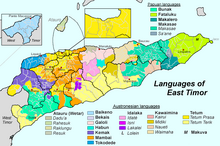This article includes a list of references, related reading, or external links, but its sources remain unclear because it lacks inline citations. (February 2008) |
| Kawaimina | |
|---|---|
| Geographic distribution | East Timor |
| Linguistic classification | Austronesian
|
| Language codes | |
| Glottolog | kawa1289 |

Kawaimina (a syllabic abbreviation of the names) is a cluster of four languages and dialects of East Timor:
spoken by one or two thousand speakers each. It is a name used by linguists discussing the languages, not the speakers themselves. The first three are spoken in adjacent areas in the western part of Baucau District, along the north coast. Naueti is used on the south coast of eastern Viqueque District, surrounded by speakers of Makasae and Makalero. Some Midiki speakers near Ossu refer to their language as Osomoko.
Geoffrey Hull classifies these as dialects and groups them into a single Kawaimina language,[1] while Ethnologue groups the varieties into three distinct languages.[2][3][4] Some authors disagree with Hull's analysis of the Kawaimina languages as a dialect chain for both diachronic changes (internal and contact-induced innovations) and synchronic reasons (phonological and morphophonological differences, morphosyntactic simplification, variable degree of Tetun and Makasae influence).[5]
The Kawaimina languages are members of the eastern Extra-Ramelaic subgroup of Timoric Austronesian languages. While structurally the languages are Malayo-Polynesian, much their vocabulary, particularly that of Naueti, derives from Papuan languages. The languages are noted for both archaisms and unusual innovations, including vowel harmony and aspirated and glottalized consonants in their sound-systems.
- ^ Geoffrey Hull (2004-08-24). "The Languages of East Timor". Macquarie University. Archived from the original on 2008-07-20.
- ^ M. Paul Lewis, Gary F. Simons, Charles D. Fennig (2016). "Nauete". Ethnologue. Dallas, Texas: SIL International. Archived from the original on 2016-08-13.
{{cite web}}: CS1 maint: multiple names: authors list (link) - ^ M. Paul Lewis, Gary F. Simons, Charles D. Fennig (2016). "Kairui-Midiki". Ethnologue. Dallas, Texas: SIL International. Archived from the original on 2016-02-04.
{{cite web}}: CS1 maint: multiple names: authors list (link) - ^ M. Paul Lewis, Gary F. Simons, Charles D. Fennig (2016). "Waima'a". Ethnologue. Dallas, Texas: SIL International. Archived from the original on 2016-03-04.
{{cite web}}: CS1 maint: multiple names: authors list (link) - ^ Veloso, Alexandre (2016). "A grammar sketch of Naueti, a language of East Timor". Leiden University. Master Thesis.



